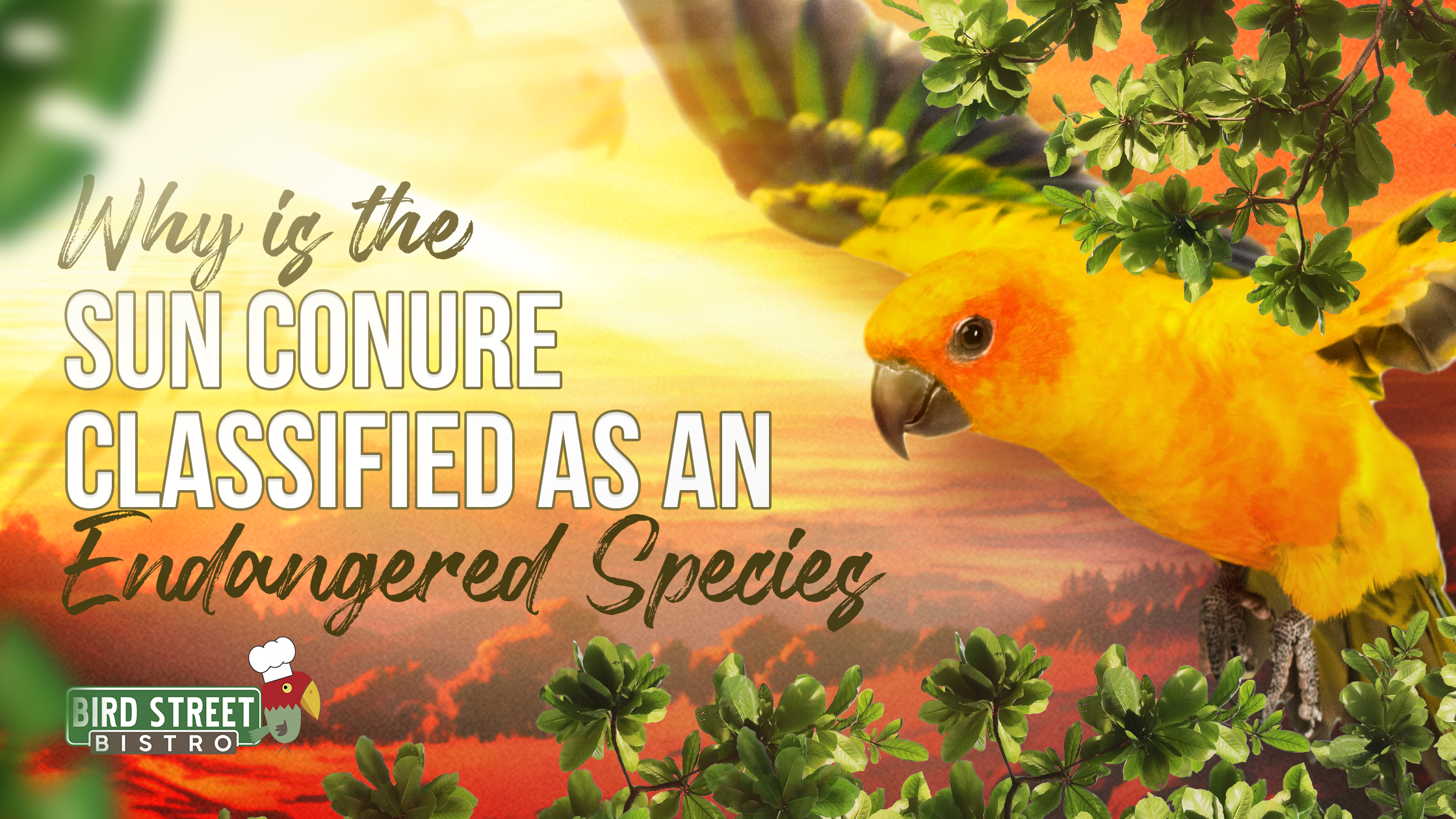Why is the Sun Conure Classified as an Endangered Species?
Sun Conures are remarkably beautiful and are one of the most recognizable parrot species due to their bright, vivid colors and expressive calls. Many people have admired these birds throughout history and they have been highly desired as a pet due to their popularity. Unfortunately, there are more Sun Conures living in captivity today than there are in the wild. This is due to a few different factors that have led to their numbers declining rapidly. Because of the threats that they face in their native habitat, they have been listed as an endangered species. So, what led to this situation and how can it be rectified? Let's take a deeper look.
The “Endangered” Sun Conure
 Sun Conures, also known as Sun Parakeets, are brightly colored, have loud, distinct vocalizations and have been reported to live up to about 30 years in captivity. They are known among parrot enthusiasts to have an adventurous attitude and playful demeanor. Although not all conures are the same, and some conures have a more subdued attitude, people still commonly regard the Sun Conure to have a large personality. They are also known to be quite loud - measuring up to about 100 decibels as demonstrated by this video uploaded on YouTube by the channel “Conure Chronicles”. This loud call helps them to communicate with each other over longer distances in the wild.
Sun Conures, also known as Sun Parakeets, are brightly colored, have loud, distinct vocalizations and have been reported to live up to about 30 years in captivity. They are known among parrot enthusiasts to have an adventurous attitude and playful demeanor. Although not all conures are the same, and some conures have a more subdued attitude, people still commonly regard the Sun Conure to have a large personality. They are also known to be quite loud - measuring up to about 100 decibels as demonstrated by this video uploaded on YouTube by the channel “Conure Chronicles”. This loud call helps them to communicate with each other over longer distances in the wild.
They come from a small area in the northeast region of South America and typically live in flocks of 15 to 30 members. They form monogamous pairs, are very affectionate with their mates, and are highly social within their flock. Some of their favorite foods in the wild are nuts, legume pods, and fruit. They have been observed to prefer nesting in palm hollows and cavities. They usually breed once per year and lay around 3 to 4 eggs at a time.
Sun Conures have been classified as “endangered.”
There are two international systems that classify a species on these lists and they are the International Union for Conservation of Nature (IUCN) and The Convention on International Trade in Endangered Species of Wild Fauna and Flora (CITES). The most recognized system is the IUCN. They use nine groups of classification that take into account the following factors: rate of decline, population size, area of geographic distribution, and degree of population and distribution fragmentation.
Why Sun Conures are Classified as Endangered
 There are a few factors that have led to the Sun Conure being assigned the status of endangered.
There are a few factors that have led to the Sun Conure being assigned the status of endangered.
Habitat Loss - This is one of the major reasons that Sun Conure’s numbers are declining. Climate change and inadequate legislation and policy enforcement on human activities such as logging and mining are some of the main contributors. Illegal logging has also sparked fires in the Amazon that have burned large amounts of forest. These factors lead to the loss of habitat and destruction of these parrots' and many other plants' and animals' homes and food sources. The Amazon, home to the Sun Conure, holds the world’s largest biodiversity on planet Earth. It is the home of hundreds of thousands of species of animals and plants. Loss of habitat means there are fewer resources to help those plants and animals to survive and thrive. Sun Conures have been observed to live in fruiting trees and palm groves. If those trees are knocked down or their numbers are thinned, there are fewer options for them to choose from. This makes it extremely difficult to safely exist, breed and find adequate nutrition.
Deforestation is an ongoing problem in the area. It is defined as the clearing of forested land that is then left baron or used for non-forest purposes such as urban development or the farming of cash crops such as palm oil and rubber. Much of the deforestation that occurs is done so illegally. Yale Environment 360 reported that “Despite international efforts to reduce deforestation, the world’s tropical forests lost 39 million acres of trees in 2017” later claiming that “That is equal to losing 40 football fields of tropical trees every minute for an entire year.”
 Trapping and Hunting - Unfortunately, it is estimated that about 800,000 Sun Conures are trapped and hunted each year for the pet trade and for their plumage. One of the ways that they are trapped is the use of nets that are placed over areas where the birds are sleeping at night. In the morning, when they attempt to fly, they are trapped in those nets. They are usually then caged in tiny containers and transported, often in inhumane and dangerous ways, to be exported for the pet trade. It's said that more than half, about 60% of the birds, don’t survive the transport.
Trapping and Hunting - Unfortunately, it is estimated that about 800,000 Sun Conures are trapped and hunted each year for the pet trade and for their plumage. One of the ways that they are trapped is the use of nets that are placed over areas where the birds are sleeping at night. In the morning, when they attempt to fly, they are trapped in those nets. They are usually then caged in tiny containers and transported, often in inhumane and dangerous ways, to be exported for the pet trade. It's said that more than half, about 60% of the birds, don’t survive the transport.
Another reason that these parrots are caught and hunted is for their plumage. The very same thing that makes them so beautiful and inspiring to many people also makes them desirable for some that would use their plumage as decoration for clothing and other items. This is perhaps one of the most heartbreaking things to talk about because these beautiful animals are being killed, without a chance to live a full life, merely for aesthetics.
On October 23rd, 1992 the Wild Bird Conservation Act was signed into law in the United States. This was done in response to many bird species’ numbers declining quickly due to excessive trapping because of the demand for pet parrots. Prior to this law taking effect, the United States was the largest importer of wild parrots. Afterward, the EU overtook the US as the largest. In 2005, they added a temporary ban on wild bird imports. In 2007, the ban was made permanent and now allows only for birds bred in captivity, and from approved countries, to be imported there.
Facing the Issues
As difficult and painful as it can be to learn what is taking place in the lives of these wild birds, it is important that we educate each other so that we can all start to make the changes needed to help them. Whether it's sharing information with those around us through classes, social media, or daily conversations, the first step is often gaining knowledge. From there, those that are able to will have the information that they need to fight for the changes required to make a difference.
It can be upsetting to discuss some of these topics. Naturally, many of us will feel the need to help. There are things that we can all do to help the birds and other animals that are facing hardship. Here are a few ideas: Making donations to reputable causes:
Making donations to reputable causes:
Conservation efforts are underway to help stop deforestation and other issues in the Amazon affecting wildlife. Every day, people risk their lives and devote their time to this noble cause. By donating to some of these organizations, you can help them and give them the tools they need on the ground and in political avenues to make a change.
Exploring the world through ecotourism:
Ecotourism is a great way to travel and learn about the magnificent animals around us. There are organizations that will give tours and provide services to tourists wanting to learn more about their causes and the animals they are helping. The funds from these tourists go back into the research and efforts of those organizations.
Volunteering:
Check out volunteering opportunities with your local agencies as well as those abroad. If you’ve got a talent and some time, you may be able to help.
Having conversations:
Talking about the issues in our homes, towns and on social media can do a lot of good. Keeping people aware of these issues by keeping the conversation going is vital for change.
All of these efforts, however small, can go far in making a difference. While we work to face the issues of wild birds and their struggles, we can take comfort and take a moment to cherish the birds in our care. Most of us will never get to experience the splendor of seeing a parrot flying through the skies in the Amazon and will only get to experience these amazing birds as companions in our homes. Giving those birds a healthy life by providing them everything that they need physically, emotionally, and nutritionally is also important in the wellbeing of parrots everywhere.
References:
“The World Lost 40 Football Fields of Tropical Trees Every Minute in 2017.” Yale Environment 360, 27 June 2018, https://e360.yale.edu/digest/the-world-lost-40-football-fields-of-tropical-trees-every-minute-in-2017.
Juniper, Tony, and Mike Parr. Parrots: A Guide to Parrots of the World. Helm, 2010.
- Choosing a selection results in a full page refresh.
- Press the space key then arrow keys to make a selection.


